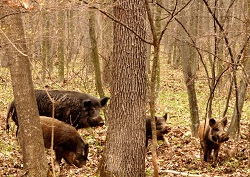Independent scientific experts, national authorities and NGOs from Belarus, the Republic of Moldova, the Russian Federation and Ukraine met to work towards the setting-up of the Emerald Network - the ecological network of areas of special conservation interest under the Bern Convention. The objective of the meeting was to assess the sufficiency of the areas already selected as Emerald sites in the countries, to ensure the long-term survival of the species and habitats of European importance.
According to the sufficiency statistics obtained as a result of the seminar, some countries have already selected the most suitable areas for ensuring the survival of nearly half of the species and habitats of European importance present on their territories. The percentages of sufficiently covered species and habitats by Emerald sites vary from country to country, within the range of 8% to 51%. Ukraine demonstrates the highest sufficiency performance, specifically with its current Emerald Network being adequate for the survival of 51% of the Emerald plant species. However, these statistics should be read with care as they are only one among many criteria (territorial coverage, quality of the background scientific data, scientific arguments, cooperation between institutions at the national level, political ownership of the process at the national level, etc.) used for monitoring the progress achieved by a country in the Emerald Network constitution process.
Most importantly, countries participating in the evaluation Seminar now hold a clearer picture of what needs to be done in order for them to reach the target – a fully functional Emerald Network.
Congratulations to all national experts from the Emerald teams for their hard work and thank you very much for all participants from the NGOs sector for their invaluable contribution and support to the Emerald process.








 Republic of Moldova
Republic of Moldova 36 sites have been identified as suitable to join the Emerald Network in the country (by February 2016), 18 of which have already been officially nominated as candidate Emerald sites by the Standing Committee to the Bern Convention in December 2015. These sites would help preserve habitats for the beautiful lady's-slipper orchid, Cypripedium calceolus, the great crested newt, Triturus cristatus, and the huchen or Danube salmon, Hucho hucho. The largest permanent freshwater salmon and more than 85 other species of plants and animals of European importance [(listed in the Emerald Network Res. 4 (1996) and Res. 6 (1998)] are identified as present in the country and should be protected by the country through the Emerald Network.
36 sites have been identified as suitable to join the Emerald Network in the country (by February 2016), 18 of which have already been officially nominated as candidate Emerald sites by the Standing Committee to the Bern Convention in December 2015. These sites would help preserve habitats for the beautiful lady's-slipper orchid, Cypripedium calceolus, the great crested newt, Triturus cristatus, and the huchen or Danube salmon, Hucho hucho. The largest permanent freshwater salmon and more than 85 other species of plants and animals of European importance [(listed in the Emerald Network Res. 4 (1996) and Res. 6 (1998)] are identified as present in the country and should be protected by the country through the Emerald Network.




























